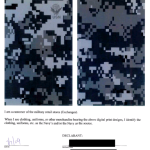Can Camouflage be a Trademark?
Can a pattern designed to make you hide in plain sight function as a trademark?
How can camouflage be a trademark?
In the case of In Re Navy Exchange Service Command, the Navy took an unusual route route to protect their camouflage pattern – applying to register it as a trademark.
My faithful readers will recall that functional elements of a design can’t serve as trademarks. Remember that an element is functional when it is essential to the use or purpose of the article or if it affects the cost or quality of the article. Isn’t the design of camouflage necessary or essential for the disguise to work?
The United States Patent and Trademark Examining Attorney – the party who examines an application for federal registration of a trademark – determined the camouflage was, in fact, functional and could not be a trademark; however, his decision was not based on the fact that the pattern served to disguise the wearer, but rather because the patterns masked stains and wear-and-tear, and those features are essential to the Navy’s requirements that uniforms be kept neat and clean.
The Trademark Trial and Appeal Board (TTAB) reviewed the Examining Attorney’s decision. The Board considered four factors to determine whether this particular design was functional:
- The existence or absence of a utility patent disclosing the utilitarian advantages of the design,
- Advertising material in which the originator of the design touted the utilitarian advantages of the design,
- The availability to competitors of alternative designs, and
- Facts indicating that the design resulted in a relatively simple or cheap method of manufacturing the product.
The TTAB was unable to find any utility patents for the Navy’s fabric design. However, they did find many alternative camouflage pattern designs that could be just as effective as the Navy’s preferred pattern. There was also no evidence that suggested that the design resulted in a simpler or cheaper method of manufacturing. This particular design by NEXCOM was not found to be superior to any other pattern chosen, and therefore had no specific function with respect to the Navy’s requirements. The TTAB also found that the design was not essential to the Navy’s requirements for uniform cleanliness.
Ultimately, because none of the elements of the pattern were essential, it was found not to be functional. Thus, the TTAB ruled that the fabric design was protectable as a trademark.
The Navy, to prove that their trademark had acquired distinctiveness (a crucial step in obtaining a trademark for this type of design), provided 25 declarations from walk-in customers at the Navy Exchange. These declarations claimed that Navy’s use of the camouflage pattern over time had led them to identify the design with the Navy.
 While a layman might look at this pattern and think it’s just like any other camouflage, the TTAB emphasized the importance of considering the relevant market. Those that regularly deal with camouflage fabric patterns could easily recognize this pattern as one that is highly distinctive of the Navy.
While a layman might look at this pattern and think it’s just like any other camouflage, the TTAB emphasized the importance of considering the relevant market. Those that regularly deal with camouflage fabric patterns could easily recognize this pattern as one that is highly distinctive of the Navy.
This case demonstrates the challenges in determining whether or not a proposed trademark design is functional. It’s not as simple as asking whether it can or does serve some sort of function. Functionality is a complicated, widely misunderstood concept in trademark law.

